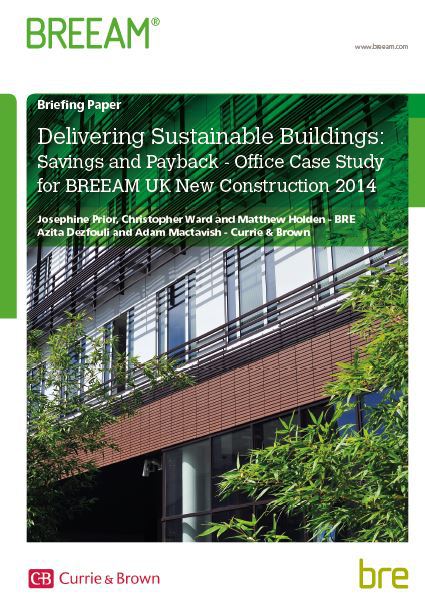Delivering Sustainable Buildings: Savings and Payback - Office Case Study for BREEAM UK New Construction 2014
While the multitude of benefits associated with investing in sustainable development practices are increasingly being recognised, for all new construction projects there is always a bottom line impact to consider.
It is for this reason that, in December 2017, a report exploring the cost implications of achieving BREEAM Very Good and Excellent assessment ratings has been undertaken and published.
The latest BREEAM Briefing Paper, titled 'Delivering Sustainable Buildings: Savings and Payback – Office Case Study for BREEAM UK New Construction 2014', uses a speculative office building project that was the basis of a similar report three years ago to review the costs of sustainability today.
The new work takes account of several factors including the increased energy performance demands of Building Regulations Part L2A and the updated assessment criteria of BREEAM UK New Construction 2014. It also examines the difference between BREEAM uplift costs for a building meeting London Plan energy requirements and the same building not so constrained.
The report is published by researchers at BREEAM and Currie & Brown, the leading international asset management and cost consultancy.
Gavin Dunn, Director at BRE, said:
“This Briefing Paper gives developers an updated picture of the cost implications of sustainable development. Both capital and lifecycle costs are considered. In particular, lifecycle costs are examined in respect of energy strategies, and water consumption, including different water supply tariffs.”
The report found that the cost uplift of achieving BREEAM UK New Construction 2014 Excellent ratings is typically less than one per cent of the total construction cost. Analysis of additional costs associated with BREEAM certification at a high standard in terms of energy efficiency and water saving technologies also showed that these costs are relatively modest and that forecast paybacks are quick – typically less than five years for energy and less than two years for water.
Adam Mactavish, operations director at Currie & Brown, points out: “Achieving a high rating under BREEAM 2014 can incur additional costs, but these are less than 1% of the total construction cost. Moreover, long-term savings on energy and water are substantial.”
The challenge for developers and clients is to make sure they consider these issues at an early stage in the design process to secure the benefits and take advantage of a building’s potential to deliver high performance standards by operating them efficiently.
To download a copy of this report see here.
This article was originally published here by BRE Buzz on 17th Dec 2017. It was written by Simon Guy.
--BRE Buzz
[edit] Find out more
[edit] Related articles on Designing Buildings Wiki
Featured articles and news
RTPI leader to become new CIOB Chief Executive Officer
Dr Victoria Hills MRTPI, FICE to take over after Caroline Gumble’s departure.
Social and affordable housing, a long term plan for delivery
The “Delivering a Decade of Renewal for Social and Affordable Housing” strategy sets out future path.
A change to adoptive architecture
Effects of global weather warming on architectural detailing, material choice and human interaction.
The proposed publicly owned and backed subsidiary of Homes England, to facilitate new homes.
How big is the problem and what can we do to mitigate the effects?
Overheating guidance and tools for building designers
A number of cool guides to help with the heat.
The UK's Modern Industrial Strategy: A 10 year plan
Previous consultation criticism, current key elements and general support with some persisting reservations.
Building Safety Regulator reforms
New roles, new staff and a new fast track service pave the way for a single construction regulator.
Architectural Technologist CPDs and Communications
CIAT CPD… and how you can do it!
Cooling centres and cool spaces
Managing extreme heat in cities by directing the public to places for heat stress relief and water sources.
Winter gardens: A brief history and warm variations
Extending the season with glass in different forms and terms.
Restoring Great Yarmouth's Winter Gardens
Transforming one of the least sustainable constructions imaginable.
Construction Skills Mission Board launch sector drive
Newly formed government and industry collaboration set strategy for recruiting an additional 100,000 construction workers a year.
New Architects Code comes into effect in September 2025
ARB Architects Code of Conduct and Practice available with ongoing consultation regarding guidance.
Welsh Skills Body (Medr) launches ambitious plan
The new skills body brings together funding and regulation of tertiary education and research for the devolved nation.
Paul Gandy FCIOB announced as next CIOB President
Former Tilbury Douglas CEO takes helm.
UK Infrastructure: A 10 Year Strategy. In brief with reactions
With the National Infrastructure and Service Transformation Authority (NISTA).
























